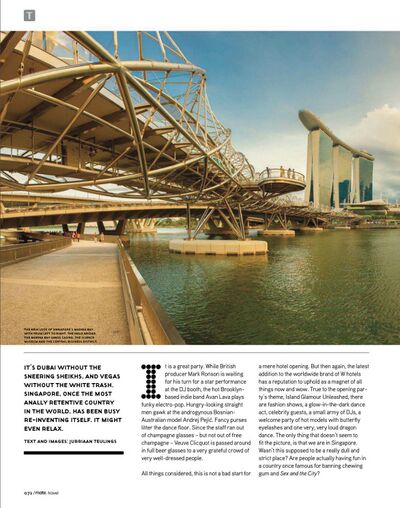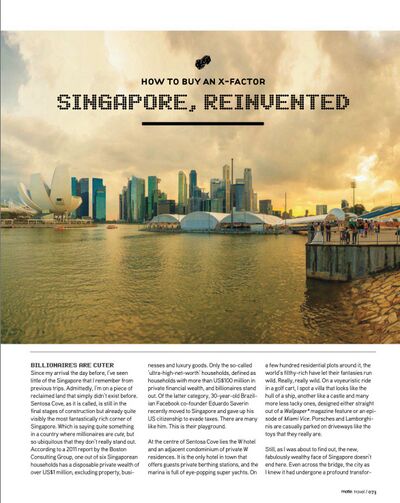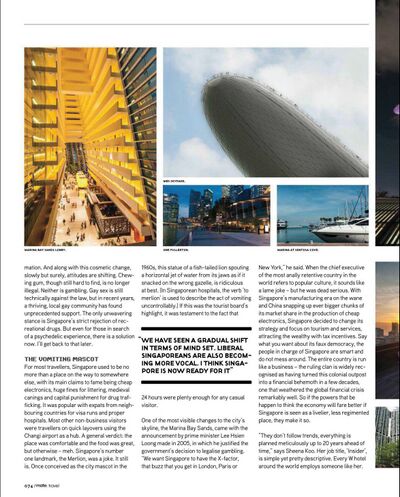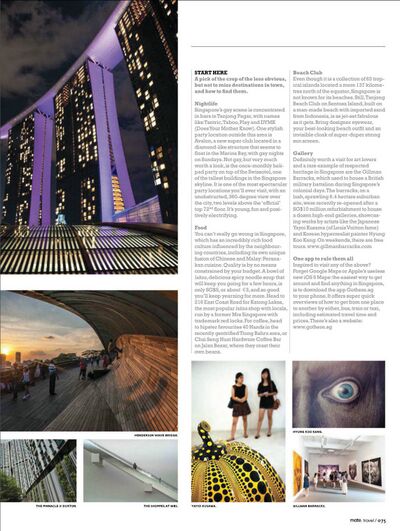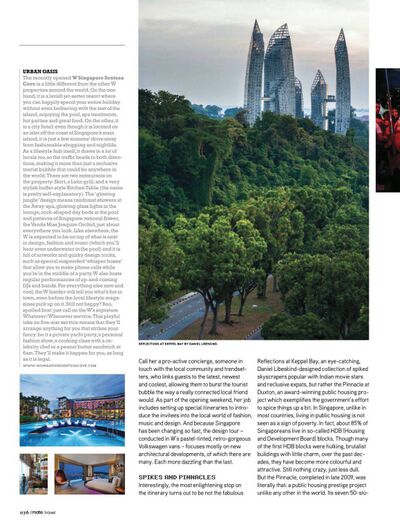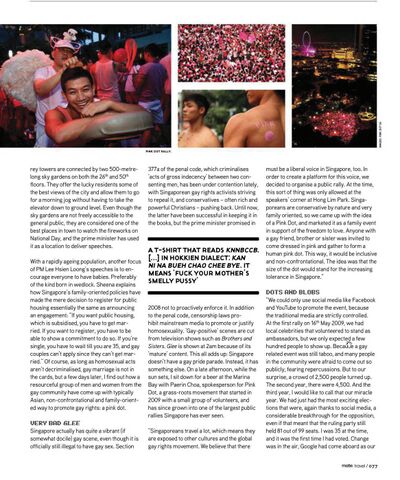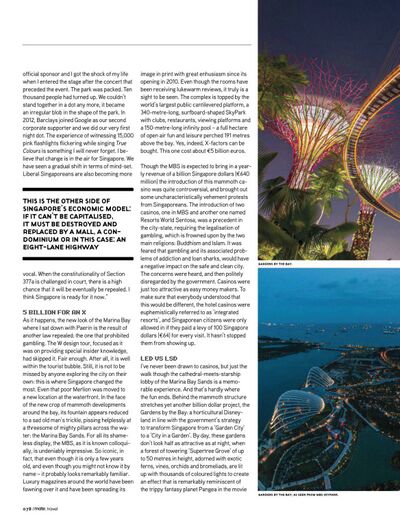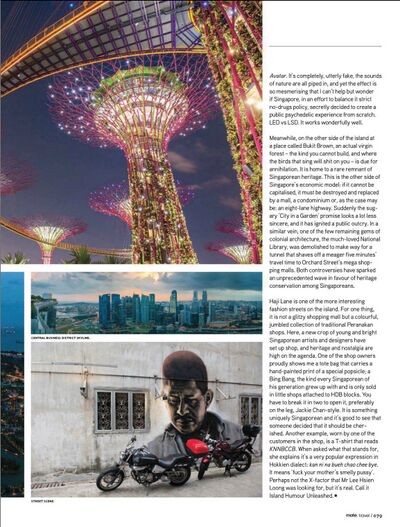Scans of the article[edit | edit source]
OCRed text of the article[edit | edit source]
HOW TO BUY AN X-FACTOR - SINGAPORE, REINVENTED[edit | edit source]
IT'S DUBAI WITHOUT THE SNEERING SHEIKHS, AND VEGAS WITHOUT THE WHITE TRASH. SINGAPORE, ONCE THE MOST ANALLY RETENTIVE COUNTRY IN THE WORLD, HAS BEEN BUSY RE-INVENTING ITSELF. IT MIGHT EVEN RELAX.
(THE NEW LOOK OF SINGAPORE'S MARINA BAY. WITH FROM LEFT TO RIGHT: THE HELIX BRIDGE, THE MARINA BAY SANDS CASINO, THE SCIENCE MUSEUM AND THE CENTRAL BUSINESS DISTRICT.
TEXT AND images: jurriaan teulings)
It is a great party. While British producer Mark Ronson is waiting for his turn for a star performance at the DJ booth, the hot Brooklyn- based indie band Avan Lava plays funky electro-pop. Hungry-looking straight men gawk at the androgynous Bosnian-Australian model Andrej Pejic. Fancy purses litter the dance floor. Since the staff ran out of champagne glasses - but not out of free champagne - Veuve Clicquot is passed around in full beer glasses to a very grateful crowd of very well-dressed people.
All things considered, this is not a bad start for a mere hotel opening. But then again, the latest addition to the worldwide brand of W hotels has a reputation to uphold as a magnet of all things now and wow. True to the opening party's theme, Island Glamour Unleashed, there are fashion shows, a glow-in-the-dark dance act, celebrity guests, a small army of DJs, a welcome party of hot models with butterfly eyelashes and one very, very loud dragon dance. The only thing that doesn't seem to fit the picture, is that we are in Singapore. Wasn't this supposed to be a really dull and strict place? Are people actually having fun in a country once famous for banning chewing gum and Sex and the City?
BILLIONAIRES ARE CUTER[edit | edit source]
Since my arrival the day before, I've seen little of the Singapore that I remember from previous trips. Admittedly, I'm on a piece of reclaimed land that simply didn't exist before. Sentosa Cove, as it is called, is still in the final stages of construction but already quite visibly the most fantastically rich corner of Singapore. Which is saying quite something in a country where millionaires are cute, but so ubiquitous that they don't really stand out. According to a 2011 report by the Boston Consulting Group, one out of six Singaporean households has a disposable private wealth of over US$1 million, excluding property, businesses and luxury goods. Only the so-called 'ultra-high-net-worth' households, defined as households with more than US$100 million in private financial wealth, and billionaires stand out. Of the latter category, 30-year-old Brazilian Facebook co-founder Eduardo Saverin recently moved to Singapore and gave up his US citizenship to evade taxes. There are many like him. This is their playground.
At the centre of Sentosa Cove lies the W hotel and an adjacent condominium of private W residences. It is the only hotel in town that offers guests private berthing stations, and the marina is full of eye-popping super yachts. On a few hundred residential plots around it, the world's filthy-rich have let their fantasies run wild. Really, really wild. On a voyeuristic ride in a golf cart, I spot a villa that looks like the hull of a ship, another like a castle and many more less tacky ones, designed either straight out of a Wallpaper* magazine feature or an episode of Miami Vice. Porsches and Lamborghinis are casually parked on driveways like the toys that they really are.
Still, as I was about to find out, the new, fabulously wealthy face of Singapore doesn't end here. Even across the bridge, the city as I knew it had undergone a profound transformation. And along with this cosmetic change, slowly but surely, attitudes are shifting. Chewing gum, though still hard to find, is no longer illegal. Neither is gambling. Gay sex is still technically against the law, but in recent years, a thriving, local gay community has found unprecedented support. The only unwavering stance is Singapore's strict rejection of recreational drugs. But even for those in search of a psychedelic experience, there is a solution now. I'll get back to that later.
THE VOMITING MASCOT[edit | edit source]
For most travellers, Singapore used to be no more than a place on the way to somewhere else, with its main claims to fame being cheap electronics, huge fines for littering, medieval canings and capital punishment for drug trafficking. It was popular with expats from neighbouring countries for visa runs and proper hospitals. Most other non-business visitors were travellers on quick layovers using the Changi airport as a hub. A general verdict: the place was comfortable and the food was great, but otherwise - meh. Singapore's number one landmark, the Merlion, was a joke. It still is. Once conceived as the city mascot in the 1960s, this statue of a fish-tailed lion spouting a horizontal jet of water from its jaws as if it snacked on the wrong gazelle, is ridiculous at best. (In Singaporean hospitals, the verb "to merlion' is used to describe the act of vomiting uncontrollably.) If this was the tourist board's highlight, it was testament to the fact that 24 hours were plenty enough for any casual visitor.
(WE HAVE SEEN A GRADUAL SHIFT IN TERMS OF MIND SET. LIBERAL SINGAPOREANS ARE ALSO BECOMING MORE VOCAL. I THINK. SINGAPORE IS NOW READY FOR IT")
One of the most visible changes to the city's skyline, the Marina Bay Sands, came with the announcement by prime minister Lee Hsien Loong made in 2005, in which he justified the government's decision to legalise gambling. "We want Singapore to have the X-factor, that buzz that you get in London, Paris or New York," he said. When the chief executive of the most anally retentive country in the world refers to popular culture, it sounds like a lame joke - but he was dead serious. With Singapore's manufacturing era on the wane and China snapping up ever bigger chunks of its market share in the production of cheap electronics, Singapore decided to change its strategy and focus on tourism and services, attracting the wealthy with tax incentives. Say what you want about its faux democracy, the people in charge of Singapore are smart and do not mess around. The entire country is run like a business - the ruling clan is widely recognised as having turned this colonial outpost into a financial behemoth in a few decades, one that weathered the global financial crisis remarkably well. So if the powers that be happen to think the economy will fare better if Singapore is seen as a livelier, less regimented place, they make it so.
"They don't follow trends, everything is planned meticulously up to 20 years ahead of time," says Sheena Koo. Her job title, 'Insider', is simple yet pretty descriptive. Every W hotel around the world employs someone like her.
START HERE[edit | edit source]
A pick of the crop of the less obvious, but not to miss destinations in town, and how to find them.
Nightlife[edit | edit source]
Singapore's gay scene is concentrated in bars in Tanjong Pagar, with names like Tantric, Taboo, Play and DYMK (Does Your Mother Know). One stylish party location outside this area is Avalon, a new super club located in a diamond-like structure that seems to float in the Marina Bay, with gay nights on Sundays. Not gay, but very much worth a look, is the once-monthly helipad party on top of the Swissotel, one of the tallest buildings in the Singapore skyline. It is one of the most spectacular party locations you'll ever visit, with an unobstructed, 360-degree view over the city, two levels above the 'official' top 72nd floor. It's young, fun and positively electrifying.
Food[edit | edit source]
You can't really go wrong in Singapore, which has an incredibly rich food culture influenced by the neighbouring countries, including its own unique fusion of Chinese and Malay: Perana-kan cuisine. Quality is by no means constrained by your budget. A bowl of laksa, delicious spicy noodle soup that will keep you going for a few hours, is only SG$5, or about €3, and so good you'll keep yearning for more. Head to 216 East Coast Road for Katong Laksa, the most popular laksa shop with locals, run by a former Mrs Singapore with trademark red locks. For coffee, head to hipster favourites 40 Hands in the recently gentrified Tiong Bahru area, or Chai Seng Huat Hardware Coffee Bar on Jalan Besar, where they roast their own beans.
Beach Club[edit | edit source]
Even though it is a collection of 63 tropical islands located a mere 137 kilometres north of the equator, Singapore is not known for its beaches. Still,Tanjong Beach Club on Sentosa Island, built on a man-made beach with imported sand from Indonesia, is as jet-set fabulous as it gets. Bring designer eyewear, your best-looking beach outfit and an invisible cloak of super-duper strong sun screen.
Gallery[edit | edit source]
Definitely worth a visit for art lovers and a rare example of respected heritage in Singapore are the Gillman Barracks, which used to house a British military battalion during Singapore's colonial days.The barracks, on a lush, sprawling 6.4 hectare suburban site, were recently re-opened after a SG$ 10 million refurbishment to house a dozen high-end galleries, showcasing works by artists like the Japanese Yayoi Kusama (of Louis Vuitton fame) and Korean hyperrealist painter Hyung Koo Kang. On weekends, there are free tours,
www.gillmanbarracks.com
One app to rule them all[edit | edit source]
Inspired to visit any of the above? Forget Google Maps or Apple's useless new iOS 6 Maps: the easiest way to get around and find anything in Singapore, is to download the app Gothere.sg to your phone. It offers super quick overviews of how to get from one place to another by either, bus, train or taxi, including estimated travel time and prices.There's also a website: www.gothere.sg
YAYOI KUSAMA. GILLMAN BARRACKS. HYUNG KOO KANG.
URBAN OASIS[edit | edit source]
The recently opened W Singapore Sentosa Cove is a little different from the other W properties around the world. On the one hand, it is a lavish jet-setter resort where you can happily spend your entire holiday without even bothering with the rest of the island, enjoying the pool, spa treatments, hot parties and great food. On the other, it is a city hotel: even though it is located on an islet off the coast of Singapore's main island, it is just a few minutes' drive away from fashionable shopping and nightlife. As a lifestyle hub itself, it draws in a lot of locals too, so the traffic heads in both directions, making it more than just a reclusive tourist bubble that could be anywhere in the world. There are two restaurants on the property: Skirt, a Latin grill, and a very stylish buffet-style Kitchen Table (the name is pretty self-explanatory). The' glowing jungle' design means rainforest showers at the Away-spa, glowing glass lights in the lounge, rock-shaped day beds at the pool and patterns of Singapore national flower, the Vanda Miss Joaquim Orchid, just about everywhere you look. Like elsewhere, the W is expected to be on top of what is next in design, fashion and music (which you'll hear even underwater in the pool) and it is full of artworks and quirky design tricks, such as special suspended 'whisper boxes' that allow you to make phone calls while you're in the middle of a party. W also hosts regular performances of up-and-coming DJs and bands. For everything else new and cool, the W Insider will tell you what's hot in town, even before the local lifestyle magazines pick up on it. Still not happy? Boo, spoiled brat: just call on theW's signature Whatever/Whenever service. This playful take on five-star service means that they'll arrange anything for you that strikes your fancy: be it a private yacht party, a personal fashion show, a cooking class with a celebrity chef or a peanut butter sandwich at 6am.They'll make it happen for you, as long as it is legal.
WWW.WSINGAPORESENTOSACOVE.COM
REFLECTIONS AT KEPPEL BAY BY DANIEL LIBESKIND.
Call her a pro-active concierge, someone in touch with the local community and trendsetters, who links guests to the latest, newest and coolest, allowing them to burst the tourist bubble the way a really connected local friend would. As part of the opening weekend, her job includes setting up special itineraries to introduce the invitees into the local world of fashion, music and design. And because Singapore has been changing so fast, the design tour -conducted in W's pastel-tinted, retro-gorgeous Volkswagen vans - focuses mostly on new architectural developments, of which there are many. Each more dazzling than the last.
SPIKES AND PINNACLES[edit | edit source]
Interestingly, the most enlightening stop on the itinerary turns out to be not the fabulous Reflections at Keppel Bay, an eye-catching, Daniel Libeskind-designed collection of spiked skyscrapers popular with Indian movie stars and reclusive expats, but rather the Pinnacle at Duxton, an award-winning public housing project which exemplifies the government's effort to spice things up a bit. In Singapore, unlike in most countries, living in public housing is not seen as a sign of poverty. In fact, about 85% of Singaporeans live in so-called HDB (Housing and Development Board) blocks. Though many of the first HDB blocks were hulking, brutalist buildings with little charm, over the past decades, they have become more colourful and attractive. Still nothing crazy, just less dull. But the Pinnacle, completed in late 2009, was literally that: a public housing prestige project unlike any other in the world. Its seven 50-storey towers are connected by two 500-metre-long sky gardens on both the 26th and 50th floors. They offer the lucky residents some of the best views of the city and allow them to go for a morning jog without having to take the elevator down to ground level. Even though the sky gardens are not freely accessible to the general public, they are considered one of the best places in town to watch the fireworks on National Day, and the prime minister has used it as a location to deliver speeches.
PINK DOT RALLY[edit | edit source]
With a rapidly ageing population, another focus of PM Lee Hsien Loong's speeches is to encourage everyone to have babies. Preferably of the kind born in wedlock. Sheena explains how Singapore's family-oriented policies have made the mere decision to register for public housing essentially the same as announcing an engagement: "If you want public housing, which is subsidised, you have to get married. If you want to register, you have to be able to show a commitment to do so. If you're single, you have to wait till you are 35, and gay couples can't apply since they can't get married." Of course, as long as homosexual acts aren't decriminalised, gay marriage is not in the cards, but a few days later, I find out how a resourceful group of men and women from the gay community have come up with typically Asian, non-confrontational and family-orient-ed way to promote gay rights: a pink dot.
A T-SHIRT THAT READS KNNBCCB. [...] IN HOKKIEN DIALECT! KAN N1 NA BUEH CHAO CHEE BYE. IT MEANS 'FUCK YOUR MOTHER'S SMELLY PUSSY'
Singapore actually has quite a vibrant (if somewhat docile) gay scene, even though it is officially still illegal to have gay sex. Section 377a of the penal code, which criminalises 'acts of gross indecency' between two consenting men, has been under contention lately, with Singaporean gay rights activists striving to repeal it, and conservatives - often rich and powerful Christians - pushing back. Until now, the latter have been successful in keeping it in the books, but the prime minister promised in 2008 not to proactively enforce it. In addition to the penal code, censorship laws prohibit mainstream media to promote or justify homosexuality. "Gay-positive" scenes are cut from television shows such as Brothers and Sisters. Glee is shown at 2am because of its "mature" content. This all adds up: Singapore doesn't have a gay pride parade. Instead, it has something else. On a late afternoon, while the sun sets, I sit down for a beer at the Marina Bay with Paerin Choa, spokesperson for Pink Dot, a grass-roots movement that started in 2009 with a small group of volunteers, and has since grown into one of the largest public rallies Singapore has ever seen.
"Singaporeans travel a lot, which means they are exposed to other cultures and the global gay rights movement. We believe that there must be a liberal voice in Singapore, too. In order to create a platform for this voice, we decided to organise a public rally. At the time, this sort of thing was only allowed at the speakers' corner at Hong Lim Park. Singaporeans are conservative by nature and very family oriented, so we came up with the idea of a Pink Dot, and marketed it as a family event in support of the freedom to love. Anyone with a gay friend, brother or sister was invited to come dressed in pink and gather to form a human pink dot. This way, it would be inclusive and non-confrontational. The idea was that the size of the dot would stand for the increasing tolerance in Singapore."
DOTS AND BLOBS[edit | edit source]
"We could only use social media like Facebook and YouTube to promote the event, because the traditional media are strictly controlled. At the first rally on 16th May 2009, we had local celebrities that volunteered to stand as ambassadors, but we only expected a few hundred people to show up. Because a gay related event was still taboo, and many people in the community were afraid to come out so publicly, fearing repercussions. But to our surprise, a crowd of 2,500 people turned up. The second year, there were 4,500. And the third year, I would like to call that our miracle year. We had just had the most exciting elections that were, again thanks to social media, a considerable breakthrough for the opposition, even if that meant that the ruling party still held 81 out of 99 seats. I was 35 at the time, and it was the first time I had voted. Change was in the air, Google had come aboard as our official sponsor and I got the shock of my life when I entered the stage after the concert that preceded the event. The park was packed. Ten thousand people had turned up. We couldn't stand together in a dot any more, it became an irregular blob in the shape of the park. In 2012, Barclays joined Google as our second corporate supporter and we did our very first night dot. The experience of witnessing 15,000 pink flashlights flickering while singing True Colours is something I will never forget. I believe that change is in the air for Singapore. We have seen a gradual shift in terms of mind-set. Liberal Singaporeans are also becoming more vocal. When the constitutionality of Section 377a is challenged in court, there is a high chance that it will be eventually be repealed. I think Singapore is ready for it now."
5 BILLION FOR AN X[edit | edit source]
As it happens, the new look of the Marina Bay where I sat down with Paerin is the result of another law repealed: the one that prohibited gambling. The W design tour, focused as it was on providing special insider knowledge, had skipped it. Fair enough. After all, it is well within the tourist bubble. Still, it is not to be missed by anyone exploring the city on their own: this is where Singapore changed the most. Even that poor Merlion was moved to a new location at the waterfront. In the face of the new crop of mammoth developments around the bay, its fountain appears reduced to a sad old man's trickle, pissing helplessly at a threesome of mighty pillars across the water: the Marina Bay Sands. For all its shameless display, the MBS, as it is known colloquially, is undeniably impressive. So iconic, in fact, that even though it is only a few years old, and even though you might not know it by name - it probably looks remarkably familiar. Luxury magazines around the world have been fawning over it and have been spreading its image in print with great enhusiasm since its opening in 2010. Even though the rooms have been receiving lukewarm reviews, it truly is a sight to be seen. The complex is topped by the world's largest public cantilevered platform, a 340-metre-long, surfboard-shaped SkyPark with clubs, restaurants, viewing platforms and a 150-metre-long infinity pool - a full hectare of open air fun and leisure perched 191 metres above the bay. Yes, indeed, X-factors can be bought. This one cost about €5 billion euros.
(THIS IS THE OTHER SIDE OF SINGAPORE'S ECONOMIC MODEL IF IT CAN'T BE CAPITALISED, IT MUST BE DESTROYED AND REPLACED BY A MALL, A CONDOMINIUM OR IN THIS CASE: AN EIGHT-LANE HIGHWAY)
Though the MBS is expected to bring in a yearly revenue of a billion Singapore dollars (€640 million) the introduction of this mammoth casino was quite controversial, and brought out some uncharacteristically vehement protests from Singaporeans. The introduction of two casinos, one in MBS and another one named Resorts World Sentosa, was a precedent in the city-state, requiring the legalisation of gambling, which is frowned upon by the two main religions: Buddhism and Islam. It was feared that gambling and its associated problems of addiction and loan sharks, would have a negative impact on the safe and clean city. The concerns were heard, and then politely disregarded by the government. Casinos were just too attractive as easy money makers. To make sure that everybody understood that this would be different, the hotel casinos were euphemistically referred to as 'integrated resorts', and Singaporean citizens were only allowed in if they paid a levy of 100 Singapore dollars (€64) for every visit. It hasn't stopped them from showing up.
LED VS LSD[edit | edit source]
I've never been drawn to casinos, but just the walk though the cathedral-meets-starship lobby of the Marina Bay Sands is a memorable experience. And that's hardly where the fun ends. Behind the mammoth structure stretches yet another billion dollar project, the Gardens by the Bay: a horticultural Disneyland in line with the government's strategy to transform Singapore from a 'Garden City' to a "City in a Garden". By day, these gardens don't look half as attractive as at night, when a forest of towering 'Supertree Grove' of up to 50 metres in height, adorned with exotic ferns, vines, orchids and bromeliads, are lit up with thousands of coloured lights to create an effect that is remarkably reminiscent of the trippy fantasy planet Pangea in the movie Avatar. It's completely, utterly fake, the sounds of nature are all piped in, and yet the effect is so mesmerising that I can't help but wonder if Singapore, in an effort to balance it strict no-drugs policy, secretly decided to create a public psychedelic experience from scratch. LED vs LSD. It works wonderfully well.
GARDENS BY THE BAY. AS SEEN FROM MBS SKYPARK.
Meanwhile, on the other side of the island at a place called Bukit Brown, an actual virgin forest - the kind you cannot build, and where the birds that sing will shit on you - is due for annihilation. It is home to a rare remnant of Singaporean heritage. This is the other side of Singapore's economic model: if it cannot be capitalised, it must be destroyed and replaced by a mall, a condominium or, as the case may be: an eight-lane highway. Suddenly the sugary "City in a Garden' promise looks a lot less sincere, and it has ignited a public outcry. In a similar vein, one of the few remaining gems of colonial architecture, the much-loved National Library, was demolished to make way for a tunnel that shaves off a meager five minutes' travel time to Orchard Street's mega shopping malls. Both controversies have sparked an unprecedented wave in favour of heritage conservation among Singaporeans. Haji Lane is one of the more interesting fashion streets on the island. For one thing, it is not a glitzy shopping mall but a colourful, jumbled collection of traditional Peranakan shops. Here, a new crop of young and bright Singaporean artists and designers have set up shop, and heritage and nostalgia are high on the agenda. One of the shop owners proudly shows me a tote bag that carries a hand-painted print of a special popsicle; a Bing Bang, the kind every Singaporean of his generation grew up with and is only sold in little shops attached to HDB blocks. You have to break it in two to open it, preferably on the leg, Jackie Chan-style. It is something uniquely Singaporean and it's good to see that someone decided that it should be cherished. Another example, worn by one of the customers in the shop, is a T-shirt that reads KNNBCCB. When asked what that stands for, she explains it's a very popular expression in Hokkien dialect: kan ni na bueh chao chee bye. It means 'fuck your mother's smelly pussy'. Perhaps not the X-factor that Mr Lee Hsien Loong was looking for, but it's real. Call it Island Humour Unleashed."
